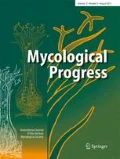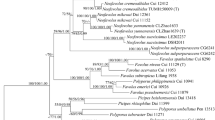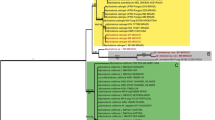Abstract
Marasmius is a widely represented genus in tropical areas, particularly in the Neotropics, which holds exceptional diversity. Previous studies have shown that traditional sections of the genus (e.g. sensu Singer) are still in conflict with phylogenetic data. This paper addresses some issues concerning morphology at the sectional level, section Neosessiles in particular, with regards to taxonomic concepts and partial phylogenetic relationships of new Neotropical species with interesting combinations of inter-sectional characteristics. Taxa descriptions in this study include Marasmius conchiformis sp. nov., M. conchiformis var. dispar var. nov., M. conchiformis var. lenipileatus var. nov., M. griseoroseus, M. griseoroseus var. diminutus var. nov., M. linderoides sp. nov., and M. longisetosus sp. nov. Some of these taxa have pleurotoid habit, and because this condition is poorly known in Marasmius, we considered it appropriate to look at their phylogenetic placement with respect to other species of the genus. We conducted Bayesian and Maximum Likelihood analyses on ribosomal 28S long subunit (LSU) and internal transcribed spacer (ITS) alignments to verify the singularity of the new taxa and to make an assessment of their relationships, regarding morphology, to other species of Marasmius. Overall, molecular and morphological data do support three new distinctive species and three varieties. Part of our findings also supports the view of some macromorphological and micromorphological characters as being highly homoplasic.












Similar content being viewed by others
References
Agerer R, Boidin J (1981) The genus Amyloflagellula in West-Africa (Basidiomycetes, Cyphellaceae). Sydowia 34:1–12
Aime MC, Phillips-Mora W (2005) The causal agents of witches’ broom and frosty pod rot of cacao (chocolate, Theobroma cacao) form a new lineage of Marasmiaceae. Mycologia 97:1012–1022
Antonín V (1991) Studies in marasmioid fungi – VI. A new subsection Sicciformes within Marasmius section Marasmius and a key to the European species of Marasmius section Marasmius. Acta Mus Moraviae Sci Nat 76:145–147
Antonín V (2007) Monograph of Marasmius, Gloiocephala, Palaeocephala and Setulipes in tropical Africa. Fungus flora of tropical Africa. Meise 1:1–164
Antonín V, Buyck B (2006) Marasmius (Basidiomycota, Marasmiaceae) in Madagascar and the Mascarenes. Fungal Divers 23:17–50
Antonín V, Noordeloos ME (2010) A monograph of marasmioid and collybioid fungi in Europe. IHW-Verlag, Eching
Antonín V, Ryoo R, Shin HD (2010) Marasmioid and gymnopoid fungi of the Republic of Korea. 2. Marasmius sect. Globulares. Persoonia 24:49–59
Antonín V, Ryoo R, Shin HD (2011) Marasmioid and gymnopoid fungi of the Republic of Korea. 4. Marasmius sect. Sicci. Mycol Progress 11:615–638
Bodensteiner P, Binder M, Moncalvo JM, Agerer R, Hibbett DS (2004) Phylogenetic relationships of cyphelloid homobasidiomycetes. Mol Phylo Evol 33:501–515
Bononi VLR, Trufem SFB, Grandi RAP (1981) Fungos macroscópicos do Parque Estadual das Fontes do Ipiranga, São Paulo, Brasil, depositados no Herbário do Instituto de Botânica. Rickia 9:37–53
Chapela IH, Rehner SA, Schultz TR, Mueller UG (1994) Evolutionary history of the symbiosis between fungus-growing ants and their fungi. Science 266:1691–1694
Corner EJH (1996) The agaric genera Marasmius, Chaetocalathus, Crinipellis, Heimiomyces, Resupinatus, Xerula and Xerulina in Malesia. Nova Hedwig Beih 111:1–164
Darriba D, Taboada GL, Doallo R, Posada D (2012) jModelTest 2: more models, new heuristics and parallel computing. Nat Methods 9:772
Dennis RWG (1951) Some tropical American Agaricaceae referred by Berkeley and Montagne to Marasmius, Collybia or Heliomyces. Kew Bull 6:347–410
Dennis RWG (1961) Fungi Venezuelani: IV. Agaricales. Kew Bull 15:67–156
Dennis RWG, Reid DA (1957) Some marasmioid fungi allegedly parasitic on leaves and twigs in the tropics. Kew Bull 12:287–292
Desjardin DE, Horak E (1997) Marasmius and Gloiocephala in the South Pacific Region: Papua New Guinae, New Caledonia, and New Zealand taxa. Part 1: Papua New Guinae and New Caledonia taxa, Part 2: New Zealand. In: Petrini O, Petrini LE, Horak E (eds), Taxonomic monographs of Agaricales II, Bibl Mycol 168:1–152
Desjardin DE, Ovrebo CL (2006) New species and new records of Marasmius from Panamá. Fungal Divers 21:19–39
Desjardin DE, Petersen RH (1989) Studies on Marasmius from eastern North America. 2. New species. Mycotaxon 34:71–92
Desjardin DE, Retnowati A, Horak E (2000) Agaricales of Indonesia. 2. A preliminary monograph of Marasmius from Java and Bali. Sydowia 52:92–194
Domingos M, Lopes MIML, De Vuono YS (2000) Nutrient cycling disturbance in Atlantic Forest sites affected by air pollution coming from the industrial complex of Cubatão, Southeast Brazil. Rev Bras Bot 23:77–85
Edgar RC (2004) MUSCLE: a multiple sequence alignment method with reduced time and space complexity. BMC Bioinforma 5:113
Fernandes AJ, Reis LAM, Carvalho A (2002) Caracterização do meio físico. In: Bicudo DC, Forti MC, Bicudo CEM (orgs.). Parque Estadual das Fontes do Ipiranga (PEFI): unidade de conservação que resiste a urbanização de São Paulo. Secretaria do Meio Ambiente do Estado de São Paulo, São Paulo, pp 51–62
Grandi RAP, Guzmán G, Bononi VLR (1984) Adições às Agaricales (Basidiomycetes) do Parque Estadual das Fontes do Ipiranga, São Paulo, SP, Brasil. Rickia 11:27–33
Hennings P (1904) Fungi S. Paulensis III a cl. Puttemans collecti. Hedwigia 48:1–20
Jenkinson TS, Perry BA, Schaefer RE, Desjardin DE (2013) Cryptomarasmius gen. nov. established in the Physalacriaceae to accommodate members of Marasmius section Hygrometrici. Mycologia. doi:10.3852/11-309
Justo A, Vizzini A, Minnis AM, Menolli N Jr, Capelari M, Rodríguez O, Malysheva E, Contu M, Ghignone S, Hibbett DS (2011) Phylogeny of Pluteaceae (Agaricales, Basidiomycota): taxonomy and character evolution. Fungal Biol 115:1–20
Kearse M, Moir R, Wilson A, Stones-Havas S, Cheung M, Sturrock S, Buxton S, Cooper A, Markowitz S, Duran C, Thierer T, Ashton B, Meintjes P, Drummond A (2012) Geneious basic: an integrated and extendable desktop software platform for the organization and analysis of sequence data. Bioinformatics 28:1647–1649
Küppers H (2002) Atlas de los colores. Editorial Blume, Barcelona
Mata JL, Halling RE, Petersen RH (2004) New species and mating system reports in Gymnopus (Agaricales) from Costa Rica. Fungal Divers 16:113–129
Matheny PB, Curtis JM, Hofstetter V, Aime MC, Moncalvo J-M, Ge ZW, Slot JC, Ammirati JF, Baroni TJ, Bougher NL, Hughes KW, Lodge DJ, Kerrigan RW, Seidl MT, Aanen DK, DeNitis M, Daniele GM, Desjardin DE, Kropp BR, Norvell LL, Parker A, Vellinga EC, Vilgalys R, Hibbett DS (2006) Major clades of Agaricales: a multilocus phylogenetic overview. Mycologia 98:982–995
Moncalvo JM, Lutzoni FM, Rehner SA, Johnson J, Vilgalys R (2000) Phylogenetic relationships of agaric fungi based on nuclear large subunit ribosomal DNA sequences. Syst Biol 49:278–305
Moncalvo J-M, Vilgalys R, Redhead SA, Johnson JE, James TY, Aime MC, Hofstetter V, Verduin SJW, Larsson E, Baroni TJ, Thorn RG, Jacobsson S, Clemencon H, Miller OK Jr (2002) One hundred and seventeen clades of euagarics. Mol Phylogenet Evol 23:357–400
Nilsson RH, Kristiansson E, Ryberg M, Hallenberg N, Larsson K-H (2008) Intraspecific ITS variability in the Kingdom Fungi as expressed in the international sequence databases and its implications for molecular species identification. Evol Bioinform Online 4:193–201
Oliveira JJS, Capelari M (2012) Two new species of Marasmius section Neosessiles (Marasmiaceae) from an Atlantic rain forest area of São Paulo State, Brazil. Nova Hedwigia 95:203–210
Pegler DN (1966) Tropical African Agaricales. Persoonia 4:73–124
Pegler DN (1977) A preliminary agaric flora of East Africa. Kew Bull, Addit Ser 6:1–615
Pegler DN (1983) Agaric flora of the Lesser Antilles. Kew Bull, Addit Ser 9:1–668
Pegler DN (1986) Agaric flora of Sri Lanka. Kew Bull, Addit Ser 12:1–519
Pegler DN (1997) The Agarics of São Paulo, Brazil: an account of the agaricoid fungi (Holobasidiomycetes) of São Paulo State, Brazil. Royal Botanic Gardens, Kew
Petch, T (1948 [1947]) A revision of Ceylon Marasmii. Trans Brit Mycol Soc 31:19–47
Pivello VR, Peccinini AA (2002) A vegetação do PEFI. In: Bicudo DC, Forti MC, Bicudo CEM (orgs.). Parque Estadual das Fontes do Ipiranga (PEFI): unidade de conservação que resiste à urbanização de São Paulo. Secretaria do Meio Ambiente de São Paulo, São Paulo, pp 201–212
Puccinelli C, Capelari M (2006) Two new species of Marasmius (Basidiomycota, Marasmiaceae) from Brazil. Mycotaxon 95:295–300
Puccinelli C, Capelari M (2007) A new species of Marasmius (Basidiomycota, Marasmiaceae) and the first record of M. foliiphilus from Brazil. Cryptog Mycol 28:263–268
Puccinelli C, Capelari M (2009a) Marasmius do Parque Estadual das Fontes do Ipiranga, São Paulo, SP, Brasil: Seções Globulares, Hygrometrici, Marasmius e Neosessiles. Hoehnea 36:249–258
Puccinelli C, Capelari M (2009b) Marasmius do Parque Estadual das Fontes do Ipiranga, São Paulo, SP, Brasil: Seções Sicci. Hoehnea 36:637–655
Ronquist F, Teslenko M, van der Mark P, Ayres D, Darling A, Höhna S, Larget B, Liu L, Suchard MA, Huelsenbeck JP (2012) MrBayes 3.2: efficient Bayesian phylogenetic inference and model choice across a large model space. Syst Biol 61:539–542
Saar I, Poldmaa K, Koljalg U (2009) The phylogeny and taxonomy of genera Cystoderma and Cystodermella (Agaricales) based on nuclear ITS and LSU sequences. Mycol Progr 8:59–73
Santos PM, Funari FL (2002) Clima. In: Bicudo DC, Forti MC, Bicudo CEM (orgs.). Parque Estadual das Fontes do Ipiranga (PEFI): unidade de conservação que resiste à urbanização de São Paulo. Secretaria do Meio Ambiente de São Paulo, São Paulo, pp 141–158
Schoch CL, Seifert KA, Huhndorf S, Robertd V, Spougea JL, Levesque CA, Chen W (2012) Fungal Barcoding Consortium: nuclear ribosomal internal transcribed space (ITS) region as a universal DNA barcode marker for Fungi. PNAS 109:6241–6246
Schulz B, Wanke U, Draeger S, Aust H-J (1993) Endophytes from herbaceous plants and shrubs: effectiveness of surface sterilization methods. Mycol Res 97:1447–1450
Secretaria do Meio Ambiente (2000) Atlas das unidades de conservação ambiental do estado de São Paulo. Secretaria do Meio Ambiente, São Paulo
Singer R (1948) Diagnoses fungorum novorum agaricalium. Sydowia 2:26–42
Singer R (1958) New Genera of Fungi. VIII. Notes concerning the sections of the genus Marasmius Fr. Mycologia 50:103–110
Singer R (1959 [1958]) Studies towards a monograph of the South American species of Marasmius. Sydowia 12:54–145
Singer R (1965) Monographic studies of South American Basidiomycetes, especially those of east slope of Andes and Brazil. 2. The genus Marasmius in South America. Sydowia 18:106–358
Singer R (1976) Marasmieae (Basidiomycetes—Tricholomataceae). Fl Neotrop Monogr 17:1–347
Singer R (1986) The agaricales in modern taxonomy, 4th edn. Koeltz Scientific Books, Koenigstein
Singer R (1989) New taxa and new combinations of Agaricales (Diagnoses fungorum novorum agaricalium IV). Fieldiana Bot 21:1–133
Stamatakis S (2006) RAxML-VI-HPC: maximum likelihood-based phylogenetic analyses with thousands of taxa and mixed models. Bioinformatics 22:2688–2690
Tan Y-S, Desjardin DE, Perry BA, Vikineswary S, Noorlidah A (2009) Marasmius sensu stricto in Peninsular Malaysia. Fungal Divers 37:9–100
Ventura A, Berengut G, Victor MAM (1966 [1965]) Características edafo-climáticas das dependências do Serviço Florestal do Estado de São Paulo. Silvic. S. Paulo, São Paulo, vol. 4/5, pp 57–140
Walther G, Garnica S, Weiss M (2005) The systematic relevance of conidiogenesis modes in the gilled Agaricales. Mycol Res 109:525–544
Wannathes N, Desjardin DE, Hyde KD, Perry BA, Lumyong S (2009) A monograph of Marasmius (Basidiomycota) from Northern Thailand based on morphological and molecular (ITS sequences) data. Fungal Divers 37:209–306
Wilson AW, Desjardin DE (2005) Phylogenetic relationships in the gymnopoid and marasmioid fungi (Basidiomycetes, euagaric clade). Mycologia 97:667–679
Xavier AF, Bolzani BM, Jordão S (2008) Unidades de Conservação da Natureza no Estado de São Paulo. In: Rodrigues RR, Bononi VLR (orgs.). Diretrizes para a Conservação e restauração da Biodiversidade no Estado de São Paulo. Secretaria do Meio Ambiente do Estado de São Paulo, São Paulo, pp 22–43
Acknowledgments
The authors thank Antônio Víctor da Costa for his knowledge of the trails and assistance in collecting specimens in the field; Klei Sousa for the illustrations; Dr. Jean-Marc Moncalvo at the Royal Ontario Museum (ROM) for permiting the inclusion of ITS/LSU sequences of M. griseoroseus in the analyses and general instructions; the anonymous reviewers for relevant contribution to this paper; Fundação de Amparo à Pesquisa do Estado de São Paulo for financial support (FAPESP 2011/02269-1 granted to Jadson J.S. Oliveira, FAPESP 2009/53272-2 granted to Marina Capelari) and Conselho Nacional de Desenvolvimento Científico e Tecnológico (CNPq) for financial support to Marina Capelari. This paper is part of a Doctoral thesis project that was developed in the “Programa de Pós-graduação em Biodiversidade Vegetal e Meio Ambiente” program at the Instituto de Botânica.
Author information
Authors and Affiliations
Corresponding author
Rights and permissions
About this article
Cite this article
de Oliveira, J.J.S., Sanchez-Ramirez, S. & Capelari, M. Some new species and new varieties of Marasmius (Marasmiaceae, Basidiomycota) from Atlantic Rainforest areas of São Paulo State, Brazil. Mycol Progress 13, 923–949 (2014). https://doi.org/10.1007/s11557-014-0978-y
Received:
Revised:
Accepted:
Published:
Issue Date:
DOI: https://doi.org/10.1007/s11557-014-0978-y




